![]()
Wednesday, July 20, 2016 | by Dr. Reuven Erlich
This is an expanded version of a presentation given by Dr. Reuven Erlich at the Second International Intelligence & Special Forces Conference, July 19, 2016. This version was first published by The Meir Amit Intelligence and Terrorism Information Center.
Overview

Two pictures symbolizing the growth of terrorism around the globe while ISIS is weakened in its core countries. Left: Fallujah, the jihadist symbol of Iraq, after its liberation from ISIS (Al-Arabiya, June 26, 2016). Right: Bodies lying on the promenade in Nice after the vehicular attack during Bastille Day festivities (YouTube.com).
A year ago I gave a presentation at the First International Intelligence & Special Forces Conference about the campaign conducted by the United States and the international coalition against ISIS. My bottom line was that the campaign had not yet succeeded in reducing ISIS’s military and governance capabilities, and that the organization was getting stronger.
During the past year the situation has fundamentally changed: ISIS’s momentum, spread and strengthening have been halted. The campaign against it has become more effective and the areas under its control in Iraq, Syria and Libya are shrinking. That is the good news. However, there is bad news as well:
- Despite the difficulties in its core countries, ISIS and its supporters have significantly increased the scope of their terrorist attacks in the Middle East and around the globe, carrying out attacks more complex and often more lethal.
- Although ISIS has been weakened over the past year, it continues to spread to other countries. The ISIS brand and its Salafi-jihadist ideology remain attractive and influence many other organizations and individuals, including those formerly affiliated with Al-Qaeda.
While the international community has had successes in their offensives, their attempts at prevention have failed, one after another. I will examine the current situation and describe the challenges and difficulties facing the two coalitions fighting ISIS, beginning with two aspects of ISIS’s weakening during the past year.
Loss of Territory
In May 2015, about a year after the declaration of the Islamic Caliphate, ISIS reached the peak of its territorial expansion in Iraq and Syria with the conquest of Ramadi and Palmyra. At that time ISIS was perceived as victorious while the military capabilities of the Iraqi and Syrian security forces were perceived as questionable. However, during the past year the tables were turned. ISIS was weakened and lost considerable territorial assets. In American administration assessment it lost almost half of the territory under its control in Iraq (47%) and about one fifth of that in Syria (20%) (as of the end of June 2016).
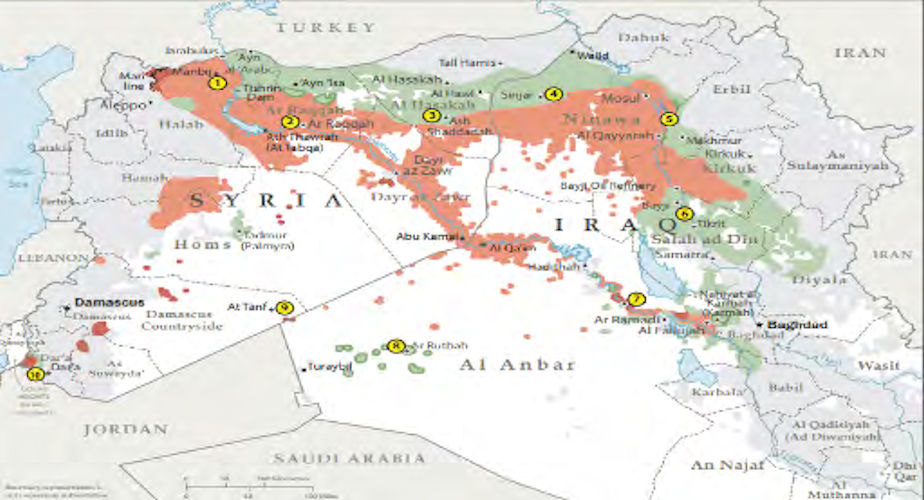
Map shown to the Senate Foreign Relations Committee by Brett McGurk, special presidential envoy for the global coalition to counter ISIS, June 28, 2016. Territories under ISIS control are marked in orange; territories lost by ISIS are marked in green.
The situation on the ground in Iraq and Syria is as follows:
- Iraq:
- During the past year several key cities have been liberated from ISIS: Tikrit and Baiji north of Baghdad; Fallujah, Ramadi and Haditha in Anbar Province, west of Baghdad; Rutbah in the border triangle of Iraq, Syria and Jordan; and Sinjar in northwestern Iraq.
- Most of the cities and surrounding villages were occupied by the Iraqi army with aerial support from the United States and the international coalition, and with support from the Shi’ite militias or Sunni tribesmen. Some, in the north, were conquered by the Kurdish Peshmerga, which proved itself an effective military force.
- ISIS operatives expelled from the cities scattered to rural or desert regions. From there they continue terrorist and guerilla attacks against Iraqi forces, Iraqi administration targets and Shi’ites (in Baghdad there was a series of savage terrorist attacks, including one in the center of the city that killed 250 civilians).
- ISIS’s control of Mosul, its “capital” and the symbol of the Islamic Caliphate, has not yet been significantly affected. ISIS still controls areas in Nineveh Province south and west of Mosul, and in several cities on the upper Euphrates as far as the Syrian border. However, those areas are increasingly under pressure from the Iraqi army, the Kurds and other fighting forces. The Iraqi army, with American support, is now establishing its control around the city of Qayyarah, 60 kilometers (about 37 miles) south of Mosul, the probable launching ground for the future campaign for the liberation of Mosul.
- Syria:
- In Syria ISIS lost two important areas: the Kurdish towns and villages along the border with Turkey (Kobanî, Tel al-Abiad and Hasakah). They were occupied by the Kurdish YPG forces with American support. The important cities in eastern Syria (Palmyra and Qaryatayn, east and southeast of Homs), were conquered by the Syrian army with Russian air support.
- The Kurdish forces and their Arab allies, the Syrian Democratic Forces (SDF), and with American aerial support, are currently fighting in Manbij, west of the Euphrates. Their objective is to take control of ISIS strongholds along the border with Turkey (Jarabulus, Al-Bab and Al-Ra’i) in a swath of land 55 kilometers long (about 34 miles) to cut off ISIS’s logistic operational supply lines.
- The Syrian army and its Iranian and Hezbollah allies recently began a military campaign (so far without results) in the direction of the core of ISIS’s key areas in Raqqah and Tabqah. However, theSyrian regime and its allies are currently concentrating their efforts on surrounding and capturing Aleppo (which they consider as of greater priority).
- The core of ISIS’s control in Syria is the city of Raqqah and a series of cities, towns and villages along the Euphrates in the Deir al-Zur and Raqqah provinces. ISIS also continues to maintain a presence, directly or through affiliated organizations, around Damascus, the border triangle of Iraq, Syria and Jordan, and in the Aleppo region. However, its operatives in those areas are hard-pressed by both the Syrian regime and other rebel organizations, and some are cut off from ISIS’s core areas.

Iraqi army “victory pictures.” Left: Iraqi soldiers fly the Iraqi flag near government buildings in the center of Ramadi, the capital of Anbar Province. Right: A soldier holds the Iraqi flag in Ramadi atop Anbar Province police headquarters (Al-Sumaria, December 28, 2015).
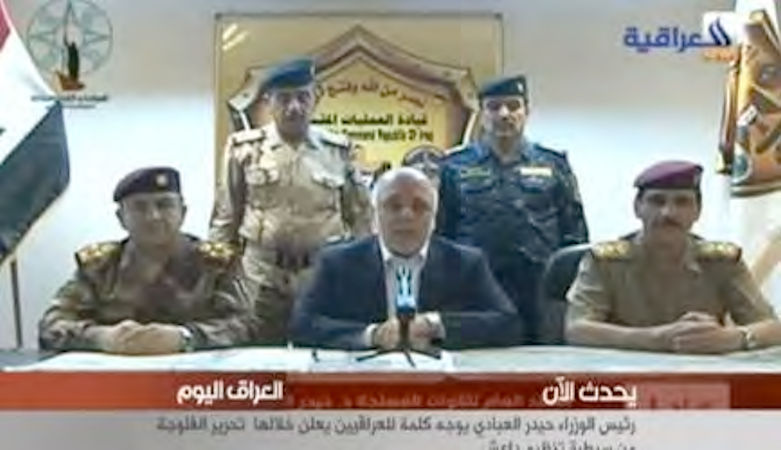
Iraqi Prime Minister Haidar al-Abadi declares the liberation of Fallujah (Al-Iraqiya TV, June 26, 2016).

Left: “Victory picture:” Iraqi Prime Minister Haidar al-Abadi raises the Iraqi flag in Fallujah (Al-Iraqiya TV, June 26, 2016). Right: The Iraqi prime minister (center) tours Fallujah accompanied by senior Iraqi army officers (Twitter account of the special operations branch of the Iraqi army, June 26, 2016).
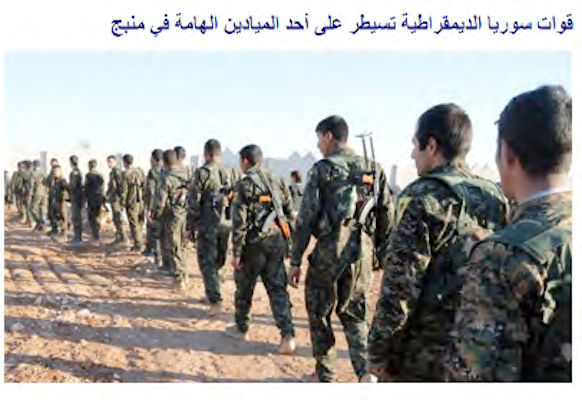
Fighters of the Syrian Democratic Forces (SDF), supported by the United States and reinforced by the Kurdish forces in Syria (YPG), at the western entrance to the Syrian city of Manbij, west of the Euphrates (Fars, June 18, 2016).
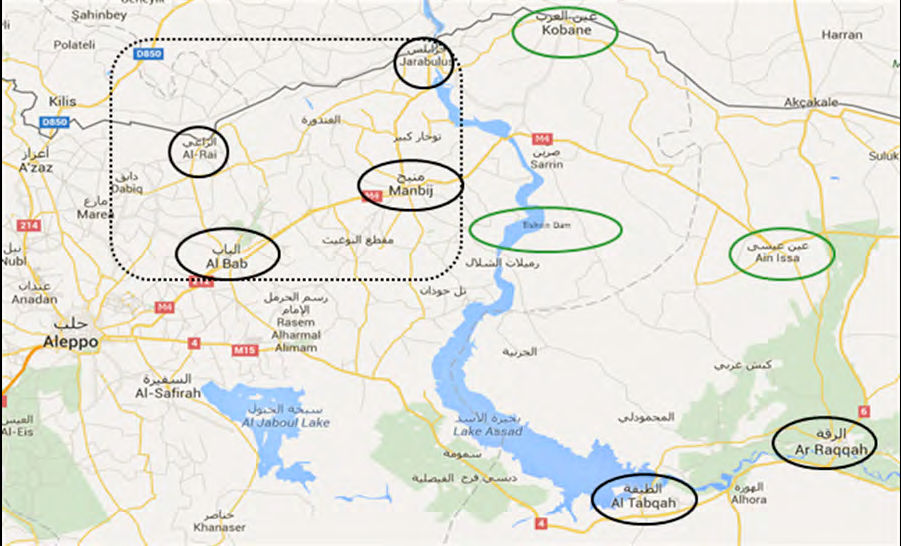
Region of ISIS control near the Turkish border, west of the Euphrates. The main ISIS strongholds are Manbij, Jarabulus, al-Bab and Al-Ra’i (Google maps). Losing control of the area will severely disrupt ISIS’s logistics, but may cause serious problems between Turks and Kurds.
In Libya as well, ISIS’s territorial control has shrunk. It is the only country beyond Iraq and Syria where ISIS established territorial control (in the Sirte region, Qaddafi’s former stronghold). Two months ago Libyan forces, affiliated with the national consensus government, attacked ISIS in the Sirte area. They conquered most of the area under ISIS control and are currently ridding the city of ISIS operatives. The loss of the Sirte region will considerably weaken ISIS’s other strongholds in Libya, but will not drive the organization out of the country.
Impairment of Governance Capabilities
During the past year ISIS’s governance capability was impaired in its core and other areas:
- The main reason was the significant drop of tens of percentage points in ISIS’s income. That was caused by the priority given by Russia and the United States to attacking ISIS’s economic assets: they carried out frequent, precise airstrikes on ISIS-controlled oil facilities and tanker trucks. Another reason was the increase in preventive activities taken by Turkey along its border with Syria, making it difficult for ISIS to export its petroleum products. In addition, ISIS’s income from taxes and extortion has decreased because of the loss of extensive territories. However, ISIS is still an extremely rich terrorist organization, its income is greater than those of all the other organizations operating in Syria and than most of the terrorist organizations around the world (the only one richer is Hezbollah, which receives massive amounts of money from Iran every year).
- At the end of April 2016 the Russians announced their planes had destroyed more than 200 ISIS oil facilities and more than 2000 tanker trucks. On July 8, 2016, Colonel Christopher Garver, spokesman for the American-led coalition, reported that American and coalition aircraft had carried out more than 303 airstrikes on ISIS oil and gas facilities since the beginning of the campaign. He said ISIS’s income, which was estimated as $30 million a month from the illegal sale of oil and gas, had dropped by about 50% to about $15 million a month (during the second half of 2014, when ISIS flourished, its monthly income was almost $100 million a month).
- The drop in income reduced ISIS’s ability to provide cheap (or free) services to the population under its control and to a certain extent that made the Islamic State less attractive. One of the outcomes of the attacks on its oil facilities was a rise in the price of electricity and fuel in regions under ISIS control. Another was that ISIS found it hard to pay the salaries of its fighters and civilian administration (according to American assessment, the salaries of fighters were halved). That led to civilian discontent, weakened the morale and motivation of ISIS operatives, and encouraged some of the foreign fighters to return to their countries of origin. However, so far there do not seem to be signs of civil disobedience in Mosul or Raqqah, ISIS’s two “capitals,” and apparently despite the difficulties, ISIS’s grip has not significantly been challenged.

Photo issued by the Russian ministry of defense showing a Russian air force attack on oil facilities in Syria (Tass, December 30, 2015)
Why Did the Tables Turn?
In our assessment, there are four main reasons why ISIS became weaker:
- The international campaign against ISIS became more effective.
- Russia’s participation in the campaign (which began at the end of September 2015)and its massive, focused airstrikes (targeting ISIS’s sources of income) significantly increased the pressure on ISIS (although Russia also focuses its efforts on al-Nusra Front and the rebel organizations).
- The American and coalition airstrikes against ISIS have become more effective, partially the result of improved offensive intelligence capabilities (while preventive intelligence still leaves room for considerable improvement). Improved intelligence led to an increase in the successful targeted killings of ISIS operatives and precise hits on ISIS’s oil facilities and military equipment.
- Examples of the increased effectiveness of airstrikes include an attack on an ISIS convoy in the Fallujah region (June 30, 2016), killing at least 250 ISIS fighters and destroying many vehicles; and an attack on a building near Mosul where ISIS had stored large amounts of currency (January 17, 2016).
- There has been an improvement in the military capabilities of local forces in Iraq and Syria fighting ISIS. Three forces carried most of the burden: the Iraqi security forces, especially the counterterrorism unit, supported by the United States; the Kurdish Peshmerga in Iraq, and the Kurdish YPG and SDF forces in Syria, both supported by the United States; the Syrian army and its allies (Iran and Hezbollah) with Russian air support, have shown certain improvement in their abilities. The weight of other forces (Shi’ites militias, Sunni tribesmen and local forces) has been of secondary importance for military purposes.
- A decline in ISIS’s military capabilities
- The reason for the decline is the many problems ISIS has to cope with: the drop in its revenues, making it difficult to pay the salaries of its operatives; the impairment of its operatives’ mobility in Syria and Iraq and between them; growing difficulties in maintaining logistic and operational connections with countries beyond Syria and Iraq; successful targeted killings of senior ISIS operatives, mainly in airstrikes (the most prominent American achievement was the killing of “Omar the Chechen,” ISIS’s senior military operative).
- The American administration currently estimates ISIS’s number of operatives as between 18,000 and 20,000 in Iraq and Syria (as of the end of June 2016). At the height of its power, in November 2014, in ITIC assessment ISIS had about 25,000 operatives (the American assessment was 33,000). Thus ISIS has lost between a quarter and a third of its forces.
- In addition, the many casualties ISIS sustained led to a decline in the quality of its leadership and field commanders (at a Senate hearing held at the end of June 2016, the American special presidential envoy for the global coalition to counter ISIS reported that in recent months more than one hundred mid-level and senior ISIS commanders had been killed).
- Increase in Turkish preventive measures
- The Turkish security forces, which in the past turned a blind eye to the movement of ISIS operatives and materials crossing the Turkish border, began, in recent months, taking more effective action against ISIS. That was in consequence of American-led international pressure and as a reaction to the showcase attacks ISIS carried out in Turkey. In addition, Turkey enables the United States and the coalition to operate from an airfield in the southern part of the country.
- The Turkish measures impaired ISIS’s ability to transfer foreign fighters and supplies to Syria, export oil products to Turkey and send operatives on missions abroad. However, ISIS still controls a swath of 55 kilometers (about 34 miles) along the Turkish border and as long as its strongholds near Syria’s border with Turkey have not been conquered, blocking the border to ISIS traffic will not be sufficiently effective.
- Two days after the failed military coup in Turkey, the American and coalition airstrikes were renewed from the Incirlik airfield. However, only time will tell if and how the failed coup will influence the effectiveness of the Turkish security forces’ activities against ISIS.

Russia joins the aerial campaign: Russian aircraft attack ISIS targets in Raqqah, Syria (Akhbar al-Muslimin, November 14, 2015).

Scene from an American Department of Defense video documenting an attack on a building near Mosul where large amounts of ISIS cash were stored (Website of the Department of Defense, January 17, 2016). It is an example of the American-led coalition’s improved intelligence and operational capabilities.
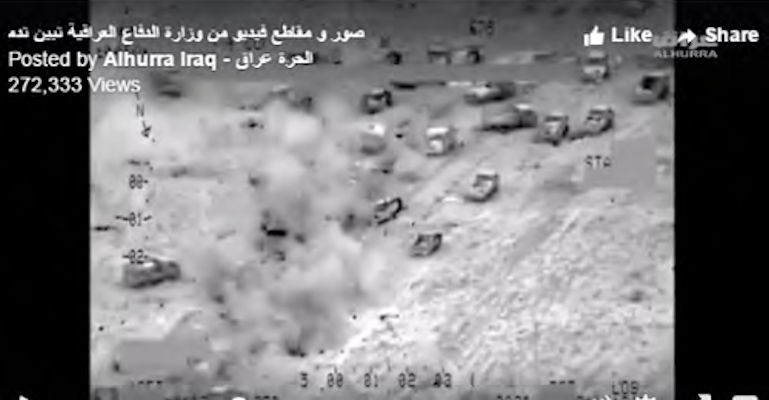
ISIS vehicles destroyed in an airstrike in the region of Fallujah on June 30, 2016 (Al-Hurrah, June 30, 2016). According to an American report, 250 operatives were killed in the strike.
ISIS’s Terrorist Campaign
So far we have dealt with the good news. Now for the bad news: first, ISIS and its supporters have significantly increased their terrorist attacks around the globe and improved their operational capabilities. Second, ISIS expanded to new regions despite the weakening ofits core; the international community and intelligence services have not yet found an appropriate response.
Intensification of terrorist attacks during the past year:
- During the past year ISIS and its affiliated supporters have carried out mass-killing attacks at airports, hotels, population centers, tourist sites, clubs, embassies, social institutions, museums, and mass gatherings, such as the Bastille Day celebrations in Nice. Their objective is to frighten and deter ISIS’s enemies and at the same time disrupt daily life and cause economic damage (especially to the tourist industry and airlines). The terrorist attacks are also intended to raise the morale of ISIS operatives and supporters by drawing attention away from the blows ISIS suffered in its core countries. So far it can be said that in France, Belgium and Turkey, the three countries at the focus of its terrorist campaign, ISIS and its supporters have had spectacular successes.
- Will the blows to ISIS’s core countries also reduce its capabilities and those of its supporters to carry out terrorist attacks around the globe? The events of the past year have shown that its weakening has in fact increased their motivation and that their operational capabilities were not affected. Abu Muhammad al-Adnani, calling on Muslims around the world to attack the enemies of the Caliphate (May 21, 2016), related specifically to that issue. He advised the United States not to delude itself into thinking that killing this or that ISIS leader would bring victory. Quite the opposite was true, he said, the Islamic State was committed to continuing the fight even if it lost Mosul, or Raqqah or Sirte, as it had fought against the United States in Iraq.
In the terrorist campaign last year three levelsof planning and execution could be discerned: at the top levelthere were operations initiated and executed by ISIS headquarters in Syria; at the local leveloperations initiated and executedby local networks and operatives in various countries; and “ISIS-inspired attacks” initiated and executed in most cases by lone wolves without direction or support from ISIS, and without its knowledge. Characteristics of the three types of attacks are the following:
The top level:
- Such attacks are complex showcase attacks and are conceived, planned and carried out by ISIS headquarters in Syria. They are directed at selected countries, such as France, Belgium, Turkey and apparently Saudi Arabia. They involve intelligence collection, dispatching operatives from Syria and establishing operational logistic networks. Such attacks are carried out by both operatives from Syria and local jihadists. Last year some of the attacks were prevented by local security services, but those that were carried out were lethal and received considerable media resonance.
- The first top-level showcase attack, which heralded a series of other such attacks, was a combined terrorist attack carried out on November 13, 2015, in Paris, and killed 132 people. It was carried out by eight terrorists operating in three teams at six locations (the Bataclan theatre, cafés, restaurants and the stadium in the northern suburb of St. Denis). It was planned and directed by ISIS headquarters in Syria and demanded a different kind of operational thinking. It also demanded early logistic, operational and intelligence-collecting preparations, in Paris and Belgium (the operation’s logistic center).
- During the past year several top-level showcase attacks were carried out:
- Three suicide bombing attacks in Saudi Arabia, July 4, 2016.
- The suicide bombing attack at the Ataturk International Airport in Istanbul (46 dead), the night of June 28, 2016.
- The suicide bombing attack at the airport in Brussels (11 killed), and the attack in the Brussels subway station (20 killed), March 22, 2016.
- The suicide bombing attack on Istiklal Street in Istanbul (four killed, three of them Israelis), March 19, 2016.
- The suicide bombing attack at the tourist site near the Blue Mosque in the Sultanahmet district in Istanbul (11 killed), January 12, 2016.
- Blowing up the Russian plane in the skies over the Sinai Peninsula (more than 220 killed), October 31, 2015.
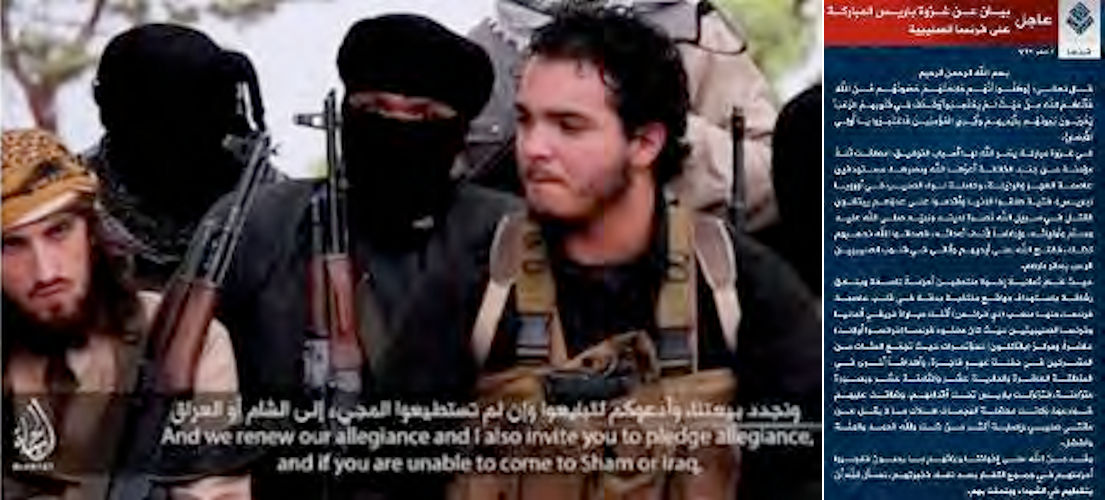
Left: Picture from an ISIS video showing a French-speaking ISIS operative calling for more terrorist attacks in France (Al-Jazeera, November 13, 2016). Right: ISIS’s claim of responsibility for the terrorist attack in Paris on November 13, 2015.

Abdelhamid Abaaoud, aka Abu Umar the Belgian, on the front cover of ISIS’s English-language magazine, Dabiq (Issue #7, February 2015). He said ISIS sent him to Belgium on a terrorist mission. The squad was exposed by the Belgian security forces, but he escaped and returned to Syria. A short time later ISIS sent him back to Europe and he headed the network that carried out the terrorist attack in Paris.

Left: The first explosion at the Ataturk airport in Istanbul, captured by airport security cameras (YouTube, June 29, 2016). Right: The entrance to the Ataturk airport after the attack (Al-Marsad News, June 29, 2016).
The local level[1]
- Local terrorist attacks are conceived, planned and carried out in ISIS’s provinces in Iraq, Syria, Libya and other ISIS provinces around the globe. They are the most common type of ISIS terrorist attack (while there are few top-level attacks).
- Prominent local-level attacks were carried out in Arab-Muslim countries:
- Car bomb in the heart of Baghdad and an attack in a shopping center (250 killed), July 2, 2016.
- Suicide bombing attack at the Pakistani consulate in Jalalabad, Afghanistan (seven security guards killed), July 2, 2016.
- Attack in a café in Dhaka, the capital of Bangladesh (20 killed), July 1, 2016.
- A series of suicide bombing attacks in Latakia and Jableh, Alawite strongholds on the Syrian coast (more than 150 killed), May 23, 2016.
- Car bomb detonated and suicide bombing attack in the town of Set Zaynab in southwestern Syria, sacred to Shi’ites (more than 80 killed in the first attack and almost 70 in the second), January 31, 2016.
- A series of suicide bombing attacks in the Christian town of al-Qaa in the Beqa’a Valley in Lebanon (between 15 and 20 killed), January 27, 2016.
- Shooting attack in the Tunisian seaside resort city of Sousse (38 killed, almost half of them British tourists), January 26, 2016.
- A suicide bombing attack at the Syrian Rukban refugee camp located in northeastern Jordan, near the border (six killed), January 21, 2016.
- Car bomb detonated at the police training facility in Zintan in northwestern Libya (at least seven killed), January 7, 2016.

Left: Scene from the site of an explosion at a shopping center in the heart of Baghdad that claimed the lives of 250 civilians (Al-Sumaria, July 3, 2016). Right: Shopping center before and after the mass-killing ISIS attack (Haq, July 3, 2016).
“ISIS-inspired attacks” carried out by ISIS supporters:
- Before the second half of 2015 “ISIS-inspired attacks” were the main type of terrorist attack carried out, directed mainly against Western countries. However, as ISIS’s operational capabilities matured, its attacks became more complex and thoroughly planned. Nevertheless, “ISIS-inspired attacks” are still occasionally carried out, in most cases by lone terrorists inspired by ISIS’s jihadist ideology and its calls to Muslims around the world to carry out attacks (the social networks affiliated with the global jihad play a central role in marketing ISIS’s ideology and spreading the call for attacks). Such attacks are carried out without direction, instructions or support from ISIS headquarters or local networks, making it very difficult to predict and prevent them.
- Calls around the globe to Muslims, especially in the West, to attack “infidels” in any way possible:
- About three months ago, on April 16, 2016, ISIS spokesman Abu Muhammad al-Adnani called on every observant Muslim “to kill the infidels, the Americans, the French and their allies.” He said that anyone who could not kill them with a bomb or gun had to take other measures such as throwing rocks, slitting throats, carrying out vehicular attacks, and burning their homes and businesses (Akhbar Dawlat al-Islam, April 16, 2016).
- About two months ago, on May 21, 2016, ISIS spokesman Abu Muhammad al-Adnani launched a new campaign of threats (in a number of languages, including English, French and German). He called on supporters of the Islamic Caliphate in Europe and America to attack the “Crusaders,” i.e., Christians, and to kill them. He emphasized that there was no need to shy away from killing civilians because there were no innocents in the “Crusader countries.” “Know,” he said, “that the countries of the Crusaders…are not immune to blood and there is no such thing as innocence…know that your attack on civilians is more desirable and effective for us because it hurts them more.”
- Abu Muhammad al-Adnani’s call fell on willing ears. Since then there have been several prominent “ISIS-inspired attacks,” most of them by lone wolves, in France, the United States and Israel:
- An axe attack in a train in southern Germany (5 wounded), July 18, 2016.
- Vehicular attack in Nice (84 killed, more than 200 wounded), Bastille Day, July 14, 2016.
- Killing of French policeman and his partner in the town of Magnanville, about 50 kilometers (31 miles) north of Paris, July 13, 2016.
- Shooting attack in a gay nightclub in Orlando, Florida (49 killed), July 12, 2016.
- Shooting attack at the Sarona commercial complex in the heart of Tel Aviv, carried out by two Palestinian terrorists from Hebron, one of them influenced by ISIS ideology during his studies in Jordan (four killed), July 8, 2016.
- Shooting and attempted bombing attack at a welfare center in San Bernardino, California (14 killed), December 2, 2015.

Left: ISIS announcement issued on June 12, 2016, stating that an “ISIS fighter” had carried out the attack in Orlando (Haq, June 13, 2016). Right: Omar Sadiqi Mateen, the terrorist who carried out the shooting attack in the gay nightclub in Orlando, Florida (Haq, June 12, 2016).
Significant progresshas been made in the offensive campaign against ISIS in its core countries while defensive operations (prevention and security) have failed time after time. That has been particularly obvious in France and Turkey, two countries in ISIS’s crosshairs. The vehicular attack in Nice clearly illustrates that improvements have to be made in prevention and security to provide an appropriate response to the challenges presented by ISIS’s terrorist attacks.
Fundamental changes have to be made in many fields: prevention (early intelligence about intentions to carry out terrorist attacks and the networks involved), security (closing security gaps that make it easy to carry out mass-killing attacks like the ones in Nice and Istanbul), inter-coalition and international collaboration (currently lacking), and legislation (to provide the security services with better tools to fight terrorism). Special attention has to be paid to radicalization in Islamic communities in the West and a response has to be found for “ISIS-inspired attacks” carried out by ISIS supporters influenced by ISIS’s Salafist-jihadi preachers and ideology.
ISIS’s Expansion
During the past year, parallel to its terrorist campaign,ISIS has spread to other Muslim regions and countries. The potential for terrorism in those countries is great but has not yet been fully exploited. ISIS recently claimed that the “Islamic State” had 16 provinces outside Iraq and Syria, several in each country. Beyond Syria and Iraq, today ISIS has a significant presence in ten countries (see below):
Despite its territorial shrinking and the damage done to its governance in Iraq and Syria, the ISIS brand has not been harmed in the eyes of global jihadist operatives. On the contrary, during the past year new local organizations and networks swore allegiance to ISIS’s leader, some of them previously affiliated with Al-Qaeda, and some of them newly-formed. Some of them were supported by operatives who wereforeign fighters in Iraq and Syria and returned to their countries of origin.
The ten most prominent ISIS provinces are:
- Libya, where ISIS established three provinces. One (Tripoli Province) was, until recently, the only one beyond the borders of Iraq and Syria with territorial control; however, it is currently fighting for its survival.
- The Sinai Peninsula, where a branch of ISIS wages intensive guerilla warfare against the Egyptian security forces, especially in the north (so far the Egyptian security forces have been unable to uproot them).
- Saudi Arabia, where ISIS has two provinces that carry out sporadic terrorist and guerilla attacks against the Saudi regime and Shi’ite targets in the eastern part of the country.
- Algeria, where the ISIS province wages guerilla warfare against the Algerian armed forces.
- West Africa, where the ISIS branch is based on Boko Haram, which swore allegiance to Abu Bakr al-Baghdadi. The branch operates in Nigeria and neighboring countries.
- Afghanistan-Pakistan, ISIS’s Khorasan Province, where its operatives fight against the local regimes and the Taliban.
- Bangladesh, where ISIS operatives carry out terrorist attacks against the local administration, foreigners and so-called “infidels.”
- The Caucasus, where three ISIS provinces are based on local Salafist-jihadi networks with the support of fighters who returned from Syria and Iraq.
- Yemen, where six ISIS provinces attack the regime and the Houthi rebels.
- The Philippines, where a branch of ISIS was recently formed based on Abu Sayyaf, an organization previously affiliated with Al-Qaeda.
What Next?
In the foreseeable future, two trends will probably unfold: ISIS’s strength in its core areas will continue to be eroded until the final the campaign for the conquest of Mosul and Raqqah (which will be complex and complicated). At the same time, ISIS and its supporters will continue intensive terrorist and guerilla attacks in Syria and Iraq, other Middle Eastern countries and around the globe. So far Israel has not been in its crosshairs, but in view of the blows ISIS has and may suffer, it is liable to attempt a showcase attack against Israel to raise ISIS operatives’ morale and prove its operational capabilities.
In ITIC assessment, ISIS will continue to shrink until it finally becomes apparent that its pretensions of establishing a viable Islamic State or Islamic Caliphate were a pipe dream. However, it would be wrong to assume that destroying its territorial power base will make it disappear as a terrorist organization. Even if the cancerous growth is excised, the malignancies in Syria, Iraq and elsewhere will continue to exist by making the necessary changes to adapt to the new conditions. In those circumstances, ISIS will once again become a Sunni jihadist terrorist organization as it was initially, but with significantly improved operational capabilities.
There are many reasons why ISIS will not disappear and be destroyed; this is not the place to analyze them. The main reason, however, is the Middle Eastern upheavals which brought about the dismantling of several nation states. The situation in the Middle East is notexpected to change in the foreseeable future. Thus, armed organizations in Syria, Iraq, Libya, Yemen and elsewhere will continue waging internal wars motivated by religious, sectarian and regional factors, with the involvement of foreign countries and powers. The central regimes in those failed countries will remain incapable of providing their citizens with security and basic services. That political vacuum on which ISIS arose, flourished and expanded, will continue to support ISIS’s existence even after the conquest of Mosul and Raqqah.
The United States and Russia (and the Middle East countries as well) are aware of the regional tangle accompanying the campaign against ISIS and the other jihadist organizations (especially Al-Nusra Front, Al-Qaeda’s Syrian branch). The political-strategic thinking of the United States, Russia and the international community is to return to the previous constellation of the nation states that collapsed, with the necessary amendments. However, such a concept is destined to fail, because those states cannot return to the status quo ante. A new kind of thinking is needed, based on situation on the ground. The ideas proposed by the powers in conjunction with representatives of the so-called “Syrian opposition” are not viable.
I would like to end with a few words about ISIS’s rival, Al-Nusra Front, Al-Qaeda’s Syrian branch:
- Al-Nusra Front was established in January 2012 about ten months after the outbreak of the Syrian civil war, and initially operated as a branch of the Islamic State in Iraq. In June 2013 it split off from the Islamic State and was recognized by Al-Qaeda headquarters, and became Al-Qaeda’s largest branch outside Afghanistan and Pakistan.
- The American campaign has targeted ISIS, considered more threatening. As opposed to ISIS, Al-Nusra Front collaborates with rebel organizations and does not participate in ISIS’s global terrorist attacks. It is therefore not currently targeted by the United States, only by Russia, because of the danger it poses to the Syrian regime (the regions of Adlib and Aleppo in northern Syria, where Al-Nusra Front is the dominant organization, are regarded by the Syrian regime as more important and threatened than Raqqah in the east).
- ISIS’s territorial weakening is liable to reinforce Al-Nusra Front’s potential. As a branch of Al-Qaeda, Al-Nusra Front is a future threat to the United States, the European countries and the entire international community, no less than ISIS (although Al-Nusra Front does not, at this stage, carry out terrorist attacks abroad). Moreover, Al-Nusra Front’s presence in the Golan Heights is potentially dangerous to Israel, even if so far that potential has not been realized. Thus, focusing the campaign only on ISIS will not solve the fundamental problem of jihadist terrorism.
![]()
Notes:
[1] The terrorist attacks against civilians at the local level are accompanied by guerilla warfare waged by the ISIS provinces against rival organizations and regular military forces in various countries. In such attacks ISIS makes considerable use of suicide bombers, who are apparently considered expendable, but ISIS does not seem to lack them.ISIS has claimed that during the past half year it dispatched 589 suicide bombers to blow themselves up in Iraq, Syria and Libya (Amaq, July 8, 2016). The number may be somewhat exaggerated, but it is certainly in the hundreds.



 RSS
RSS


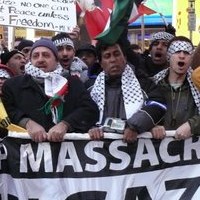

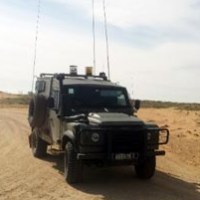






Latest Comments
... [Trackback] [...] Read More: crethiplethi.com/contact-form/trackback/ [...]...
Hello Mike, Thank you for your positive feedback to the article. I felt there wasn’t too much critical analysis of ...
Thanks for this considered and well constructed article. A follow up article on the manner in which the editorial contro...
THE CLUELESSNESS OF CLAIMING THAT OBAMA'S MIDDLE EAST POLICIES WERE A FAILURE CANNOT BE FURTHER FROM THE TRUTH, WHAT THE...
As long as Obama is the president of the usa do not trust the us government......